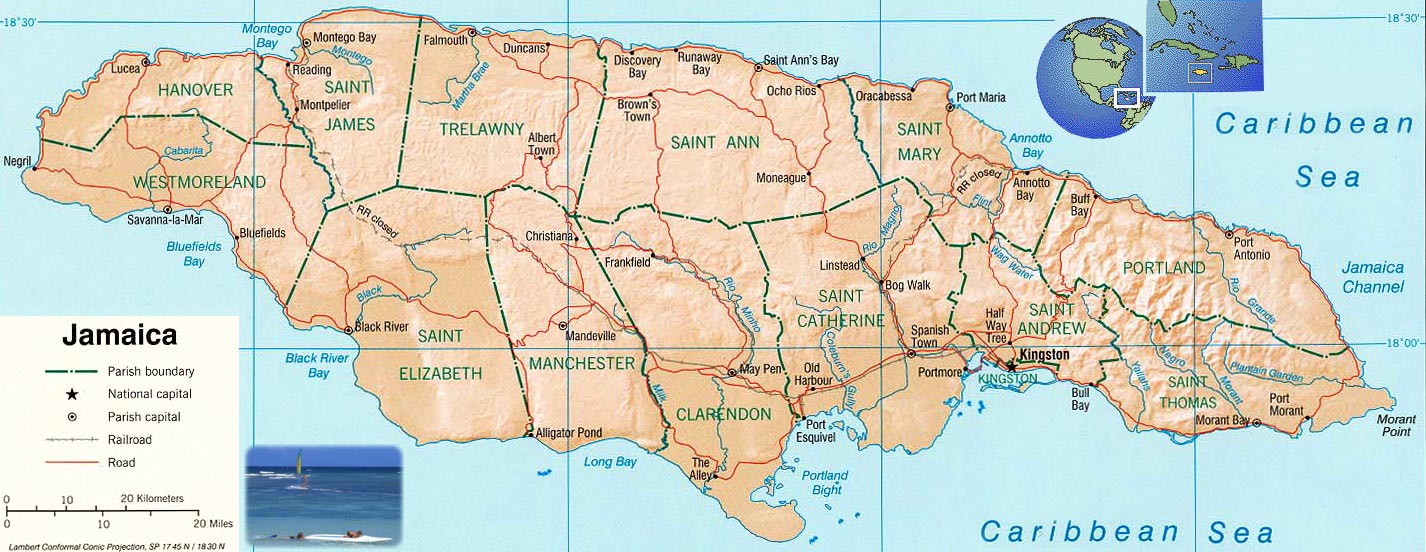
|
|

Portland, with its capital town Port Antonio, is a parish located on Jamaica's northeast coast. It is situated to the north of St. Thomas, and the east of St. Mary in Surrey county. It is one of the rural areas of Jamaica and is known for its great beaches.
History
Port Antonio was discovered in the 16th Century, by the Spanish, who named it "Puerto Anton". Portland is the result of the combination of two parishes; St. George and a part of St. Thomas. In the 18th century, the town was a British naval stronghold, and even today, there is evidence of British architecture in the parish square; the Anglican stone church, built in 1840, and the DeMontevin Lodge, 1881 — now a popular guest house on Titchfield Peninsula — and Fort George, 1729, which overlooks the harbours with its cannons pointing towards the sea. Titchfield Peninsula is also home to the The Titchfield School, 1785, which is one of the oldest and most respected private secondary schools in the Caribbean. The school is located on Fort George.
In the 1700s when sugar cane and coffee were being cultivated by African slave labour, many slaves were able to plan rebellions and escape into the mountainous interior, as the slaves outnumbered their white masters ten to one. The parish was generally uninhabited, however, and in 1723, the Governor began offering free land to white Protestants, and to free mulattos, Indians or Negroes in an attempt to populate this parish. This seemed only to attract more British, and the Maroons, who were runaway slaves living in the Blue and John Crow Mountains, were determined not to let the British take over the parish.
A series of battles took place in the 1730s, which would end when the British and the Maroon settlement, governed by "Nanny of the Maroon", sign a treaty in 1739. 'Nanny of the Maroon' would later become Jamaica's first and only National Heroine.
Tourism also played an integral role in the development of the Portland. The business began in the mid 19th century, with the exportation of banana. Port Antonio, the capital, was renowned as the 'World's Banana Capital'. Jamaica's tourism was virtually born in this parish, when banana boats returning from Boston, U.S.A. brought the first tourists to Jamaica. Another boost to the local economy occurred when Errol Flynn's yacht washed ashore in bad weather. He fell in love with the area and bought property on Navy Island, just off the coast, where he entertained his Hollywood friends.
The parish is situated at latitude 18°10' N and longitude 75°27'W. It extends from the highest peaks of the Blue Mountains, 2256 meters above sea-level, down to the north coast, and is noted for its fertile soil, beautiful scenery, and fine beaches. The parish lies in the direct path of the northeast trade winds and the Blue Mountain ridge to its south traps the moisture causing the parish to have the highest rainfall in the island. Port Antonio, its chief town and capital, has two harbours, the western one being sheltered by a small islet, Navy Island. Portland covers an area of 814 square kilometers, making it Jamaica's seventh largest parish.
The parish has a variety of complex landforms; the entire coastline is dotted with caves, bays, rivers, waterfalls and hills. There are fourteen caves, which include those at Buff Bay, Orange Bay, Hope Bay, Port Antonio, Boston Bay, Long Bay, Innis Bay and Nonsuch. There are also 17 rivers which form a network throughout the parish. The largest are the Rio Grande, Buff Bay and Hectors Rivers.
The population of Portland is an estimated 82000, 15,000 of which live in the capital town.